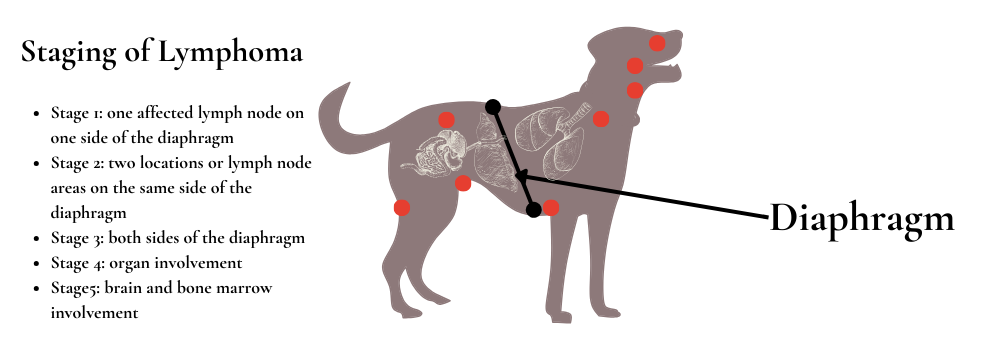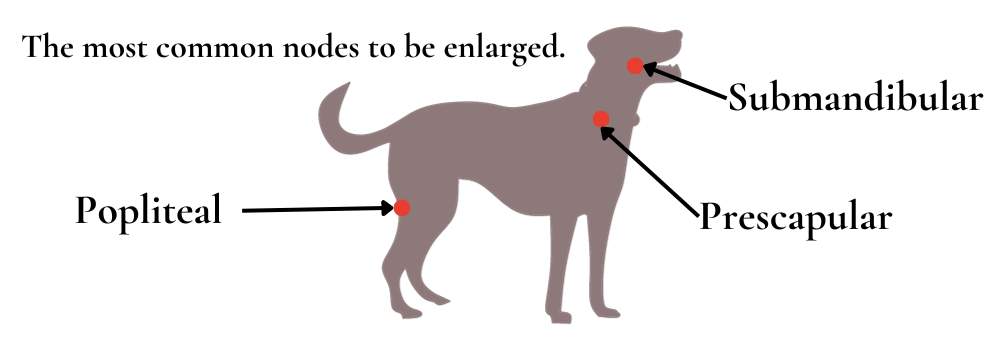
Eighty percent of dogs with lymphoma present with enlarged lymph nodes that are peripheral! If you have a breed that is overrepresented for lymphoma, it's important for you to know where these lymph nodes are so that you can detect them early. Lymphoma is typically very aggressive, so intervening early is critical. A majority of patients are becoming sick from their disease when lymphoma is found.
Typically, there is a significant wait time to see a specialist if your dog is diagnosed with lymphoma. Now, there is a treatment available for lymphoma in dogs that can be started early on when every day counts and for those who do not have access to a veterinary oncologist.
The new drug is called Laverdia, and there are very favorable reports on dogs tolerating it. Of course, being a holistic/integrative practitioner, I would never just pursue chemotherapy for a dog's lymphoma. I would consult with a holistic veterinarian and get guidance on using immune support, herbal support, and, in many cases, acupuncture to facilitate the best potential outcome. If there is one cancer that responds well to Western medication, it's lymphoma.
Lymphoma in Dogs: Symptoms, Diagnosis, and Treatment
Lymphoma is a common cancer in both humans and dogs. It is a cancer of lymphocytes, which are white blood cells that mostly reside in our lymph nodes and lymph systems.
Canine lymphoma is a common yet complex group of cancers that affects our beloved four-legged friends. It represents approximately 7-14% of all cancer diagnoses in dogs, making it one of the most prevalent canine cancers.
How common is lymphoma in dogs?
Lymphoma is one of the most common cancers. It accounts for for 7–24% of all canine tumors. It can also affect very young dogs and is seen in some breeds more so than others.
Lymphoma in dogs affects what breeds most commonly?

Lymphoma affects some dog breeds more than others, and obviously older dogs of any breed.
Boxer, bull mastiff, bull terrier, basset hound, St. Bernard, Scottish terrier, Airedale terrier, golden retriever, Dogue de Bordeaux, lurcher, English bulldog, West Highland white terrier, Bouvier des Flanders, Boerboel, border collie, Rhodesian ridgeback, Belgian shepherd, Labrador retriever, American cocker spaniel, Siberian husky, Chinese shar pei, Yorkshire terrier, Australian shepherd, Irish wolfhound, shih tzu, German shepherd dog, and rottweiler
Types of lymphoma in dogs
In dog breed, LSAs can be classified by the lymph nodes and body systems affected. The different types are:
- Multicentric lymphoma (most common) affects multiple lymph nodes
- Gastrointestinal or alimentary lymphoma: infiltrates the digestive tract
- Cutaneous lymphoma: a rare skin form
Multicentric lymphoma in dogs is the most common type of presentation. These dogs have increased lymph nodes that are peripheral lymph nodes. 80% of canine lymphomas present this way.
Peripheral lymph nodes can be felt on the outside of the body, versus lymph nodes that are located in the interior of the body where they must be detected with other methods such as ultrasound, cat scan, or exploratory surgery.
Is there a blood test for lymphoma in dogs?

There is a test that detects cancer early but may not be specific for lymphoma in dogs. Check out this video here!
Staging of lymphoma in dogs
Staging is based on the location of the tumor in relation to the diaphragm, internal versus peripheral lymph nodes, bone marrow, or nervous system involvement. The stages go from one affected lymph node to multiple, and whether it has spread to both sides of the diaphragm (think the belt line in humans) and to the brain and bone marrow.
Prognostic indicators for substaging. Substage A patients are feeling well despite their enlarged lymph nodes. Substage B patients are sick from lymphoma. Obviously, Stage A is likely going to respond better to therapy.

What does immunophenotype mean?
There are also b-cell lymphoma and t-cell lymphoma.
B cell lymphoma in dogs encompasses 80% of cases and tends to be more responsive to treatment.
T-cell lymphoma is less common, and that is good, as it's difficult to treat. Think T for terrible and B for a better outcome.
Boxers are overrepresented for having T-cell lymphoma. It often affects the thymus in the chest and is known as mediastinal lymphoma. Because it is the chest that can cause coughing. For that reason, you should never ignore a coughing Boxer.

Symptoms of Lymphoma in Dogs
- Enlarged lymph nodes are the most common sign
- Nonspecific signs include anorexia
- weight loss
- lethargy
- vomiting, diarrhea
- Respiratory distress/cough (never ignore a coughing Boxer)
- excessive water consumption and urination
- fever
Recognizing Canine Lymphoma
Detecting lymphoma in dogs can be challenging as its symptoms can often mimic other health issues. The most common signs include swelling in the lymph nodes, lethargy, loss of appetite, and weight loss. If your dog displays any of these symptoms, it's crucial to consult your vet immediately for a thorough examination and diagnosis.
Where can you feel enlarged lymph nodes?
Since 80% of canine lymphomas are present in the peripheral lymph nodes. For this reason, it's a good idea to be aware of where these are located, as the sooner you diagnose lymphoma in dogs, the better the outcome.

Tips for feeling each set of nodes, starting with the easiest ones to feel:
First things first...think massage.....you are massaging your dog. Do a light touch, no poking, and don't worry if you cannot feel the lymph nodes. Just feeling what is normal for the area is enough. Feel with your hands and close your eyes if you need to.
And if you find something, don't panic. Lymph nodes can enlarge for many reasons, from infection to inflammation. These are called reactive lymph nodes.
Submandibular lymph node: Go to the angle of the jaw. There should be a large salivary gland. Move ahead of it to find the lymph nodes, which are the size of a pea. This is typically the one that pet owners notice.
Prescapular: Feel where the shoulder blade is. Halfway from the top of the shoulder blade to the pointer front of the shoulder on the front border of the shoulder blade is where you will find these if they are enlarged. If they are not enlarged, you would not normally feel them, so don't expect to feel them.
Popliteal: These lymph nodes are in the crook of the knee in what is called the popliteal fossa. Again, you may feel nothing. Don't poke here, your dog will not like it.
Cervical: Feel on yourself where there is a furrow in your neck. This is called the jugular furrow, where the jugular vein courses. This is similar to your dog. Stroke along the neck and get used to how it feels normally.
Sublumbar: these are in the lumbar area and are typically not palpable unless they are very large
Now it's time for the belly rubs! Try to look for these when your dog is laying down or when you have them on your lap, and you are watching TV. Encourage them to roll on their back so you can feel the nonhaired area on their caudal belly.
Inguinal area: if there is a lot of fat here, you may have to gently massage it to feel it. Again, you shouldn't feel them if they are not enlarged. And if your dog has a lot of fat here, just get a sense of what it feels like as an enlarged lymph node here would have a different texture.
Axillary: they are in the armpit area and not easily palpable.
Focus on these three peripheral lymph nodes to detect lymphoma in dogs


Life Expectancy Post Diagnosis
Without treatment, lymphoma can progress rapidly, usually resulting in death within a few weeks to a few months from the time of diagnosis. While a full cure is not currently possible, treatment can put the disease into remission, extending the dog's life span considerably.
Traditional Treatment vs. Laverdia
The gold standard for chemotherapy in dogs is CHOP which stands for the beginning letters of the drugs, and I will just leave it at that! CHOP requires intravenous treatment and is conducted mostly at oncology centers as it requires special equipment/hoods and special training to handle chemotherapy agents. Despite its effectiveness, this treatment comes with various side effects, including nausea, vomiting, and hair loss.
The CHOP protocol can be costly. The cost for a Golden Retriever size dog can range from $5-10,000 for the first 6 months. Dogs typically are treated over 4-6 months with weekly visits and a lot of time spent at the veterinary clinic getting treatment, dealing with side effects, and monitoring progression. The prognosis for patients with B cell lymphoma is 1-2 years for most dogs, with some dogs living for 3 years.
Lomustine is another oral drug that is used. It is not as successful, and many dogs will have issues with their liver and neutrophils.
Many dogs are started on high doses of prednisone as the only treatment when people do not want to pursue chemotherapy. Prednisone has side effects that include excessive drinking, urination, and panting.
What are chemotherapy side effects?
When cancer is targeted, normal cells are also targeted. When normal cells are affected, we see vomiting, diarrhea, anorexia/decreased appetite, hair loss, and organ systems potentially affected. Since many people have at least a friend or family member who has had chemotherapy, the thought of having their dog go through the same negative side effects is unacceptable. But consider the aggressive protocols in humans cause these negative side effects in 8 out of 10 people.
With canine lymphoma, these side effects may only be seen in 1 in 10 dogs as the protocols are created so that dogs tolerate chemotherapy
Considerations for pursuing chemotherapy?
- Location
- Finances
- Condition at the time of diagnosis. This is so important.
- Dog's temperament
- Family situation, time for weekly veterinary visits? Pregnant individuals cannot handle many chemotherapy agents.
This leaves an overwhelming majority of people to NOT choose chemotherapy protocols for their dog.
Laverdia: A New Hope
Recently, a new oral medication named Laverdia has been released. This drug presents an alternative to traditional chemotherapy treatments, allowing pet owners a more convenient and less invasive treatment option for their pets. Studies on Laverdia are still ongoing, but initial results look promising. Most importantly, it is well tolerated in most dogs that take it.
Laverdia operates by blocking signals that allow cancer cells to grow, effectively halting the progression of the disease.
The cost of Laverdia varies widely throughout the country. It also varies greatly with the size of your dog. A Golden Retriever would cost a lot more to treat than a Jack Russell Terrier. The cost typically would run between $100-$300 per month, and additional fees for blood tests that are taken in 2 weeks after starting therapy and then monthly.
It's important to note that if you are considering chemotherapy or have to wait to see an oncologist, you should not give your dog prednisone as it may make them resistant to treatment. Laverdia is an option while you are waiting to consult with an oncologist regarding your dog's unique presentation.
Integrating Holistic Medicine in the Treatment of Lymphoma in Dogs

I recommend consulting with a veterinarian trained in herbal medicine and acupuncture if possible. I can't tell you how many people go online and consult with Dr Google and come in with bags and boxes of supplements that have been touted to treat and cure cancer. Any time you see that lymphoma was cured with this or that treatment, please close that tab. This is just wrong as it is exceedingly rare to see a cure, and many would say it's not possible to cure.
A holistic veterinarian can help you sort through and choose modalities that they have had success with and also help you choose the highest quality supplements out there.
Never ignore diet when it comes to treating dogs with lymphoma. This is the best time to choose a minimally processed diet. I would consider lightly cooked and see how your dog does before jumping to a raw diet in a potentially immunocompromised system.
Quality of Life
A diagnosis of lymphoma can be devastating. As the disease progresses rapidly, it does not leave people a lot of time to make a decision. I always tell people that they can always try a treatment, and if their dog is tolerating it well and they are not sick from their disease and feeling better with treatment, they can continue. There is an option to stop treatment at any time. For many people facing such a devastating diagnosis, every day is a gift. If Laverdia gives dogs a good quality of life for the family to have time to spend with their dog, that is quality time, it's a gift for many pet owners and their beloved dogs.
Conclusion
Canine lymphoma is a challenging diagnosis for any pet owner to face. But thanks to advancements in veterinary medicine like Laverdia, there's now more hope than ever for dogs diagnosed with this disease. It's well tolerated, which is comforting to many people embarking on treating their dog.
Always remember that early detection is key in managing this condition, especially if you have a dog that is predisposed to lymphoma. Learning what feels normal on your dog may help you detect changes quickly, in addition to regular vet check-ups, of course.
Disclaimer: This article provides general information about canine lymphoma. It does not replace professional veterinary advice. Always consult with your vet for the best treatment options for your pet.











